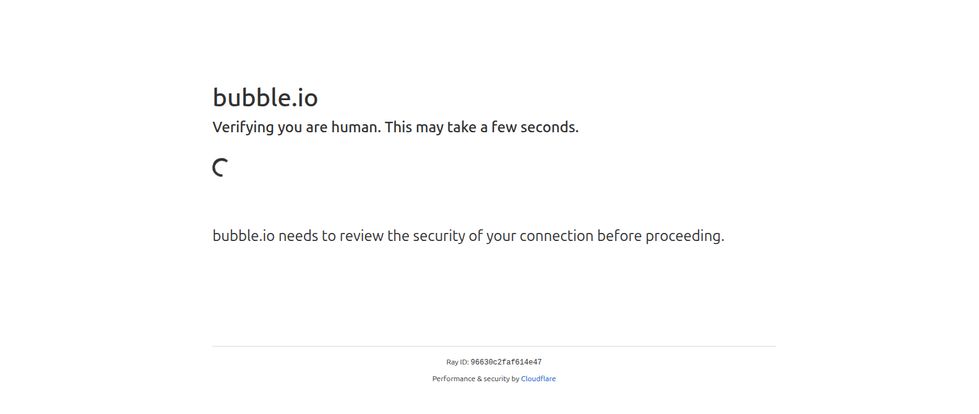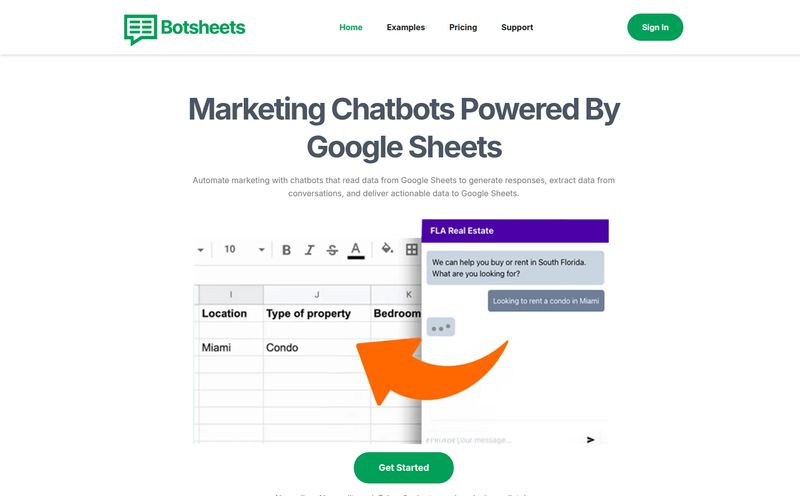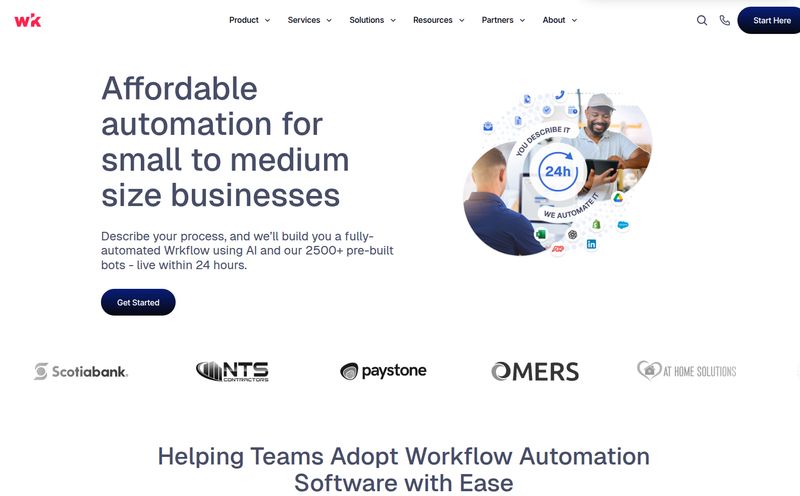I’ve been in the SEO and digital marketing game for years, and if there’s one constant, it’s the graveyard of brilliant ideas. You know what I'm talking about. That folder on your desktop, that forgotten Trello board, all filled with amazing concepts for web apps that never saw the light of day. Why? Because the barrier to entry—the coding—was just too high, too expensive or too time-consuming.
For a long time, the answer was either to spend a fortune on developers or dedicate months, maybe years, to learning a language like Python or JavaScript. But the ground is shifting. And tools like Bubble.io are causing the tremors. I’ve been hearing the buzz about Bubble for a while now, so I decided it was time to take a proper look.
Honestly, when I first landed on their site and saw a mention of AI image analysis alongside a no-code app builder, I was a bit puzzled. It felt like walking into a hardware store that also sold artisanal cheese. An odd combo, right? But stick with me, because one of these things is genuinely changing the game for entrepreneurs and creatives.
What Exactly Is Bubble? And Why Should You Care?
Let's clear the air. At its core, Bubble is a no-code development platform. Think of it less like a website builder (like Squarespace or Wix) and more like a visual programming tool. It gives you the power to build the guts of a web application—the logic, the database, the user interactions—without writing a single line of `
This is huge. It means founders, designers, and marketers can actually build their own tools. No more trying to translate your vision to a technical team. You can create your own MVP (Minimum Viable Product) over a weekend, not a quarter. The whole no-code movement is about democratizing tech creation, and Bubble is one of its loudest champions.
A Look at Bubble's Core Features
So how does it all work? It’s not magic, but it sometimes feels close. The platform is built around a few key ideas that make it so powerful.
The Visual Drag-and-Drop Editor
This is where you'll spend most of your time. The interface is a drag-and-drop canvas where you design your app's pages. Want a sign-up button? Drag it onto the page. Need a user profile picture? Drop in an image element. But here's the cool part: you then create 'workflows'. For example: "When a user clicks the 'Sign Up' button, create a new user in the database, take the text from the 'email input box' and save it to that user's email field, and then navigate them to the 'dashboard' page." You're literally programming with plain English statements. It's a completely different way of thinking about logic, and for visual thinkers, it just clicks.
The Unexpected AI Image Analysis Tool
Okay, let's talk about the artisanal cheese in the hardware store. The info I found mentioned an AI tool for analyzing images to find attributes or emotions. To be honest, this feels more like a tech demo of what's possible to build with Bubble rather than a core feature of the builder itself. It's a neat concept—imagine building an app that automatically tags user-uploaded photos for content moderation. But for 99% of people coming to Bubble, this is a sideshow. The main event is, and should be, the app builder itself. It's an interesting footnote, but dont let it distract you.
Hosting and Database All In One Place
This is a benefit that's easy to gloss over, but it’s a massive weight off your shoulders. When you build with Bubble, they handle the hosting. You don’t need to worry about AWS, server configurations, or security patches. It just… works. Your app's database is also fully integrated. This tight integration is what makes the whole system feel so cohesive. It removes a ton of technical headaches that would normally stop a non-technical founder dead in their tracks.

Visit Image Analytics & Bubble
The Real-World Power of Building with Bubble
Alright, so it's a cool concept, but can you build a real business on it? Some critics of no-code say these tools are just for simple toys and prototypes. And a few years ago, they might have had a point. Not anymore.
I did some digging and found that real, money-making companies have been built on Bubble. Companies in finance, project management, and marketplaces have used it to launch and scale. The key is knowing its sweet spot: it’s perfect for building marketplaces (like a niche Airbnb), internal tools, social networks, and all sorts of Software-as-a-Service (SaaS) products. You can connect to thousands of other services through APIs, so you’re not totally walled off. Need to process payments? Integrate with Stripe. Need to send emails? Connect to SendGrid. This extensibility is what elevates it from a simple builder to a serious platform.
Let's Talk Money: Bubble's Pricing Structure
Price is always a factor, right? Nothing kills a project faster than a bill you weren't expecting. I checked out their current pricing, and it seems pretty reasonable, especially for what you're getting. Here's a quick rundown of their general tiers (always check their official site for the latest, as these things change!):
| Plan | Best For | My Quick Take |
|---|---|---|
| Free | Learning & Hobby Projects | Incredibly generous. You can learn the entire platform and build a real, albeit branded, app without paying a dime. Perfect for testing your idea. |
| Starter | Launching Your First App | This is the first real step. It lets you use a custom domain and has more server capacity. This is where you go from hobby to potential business. |
| Growth | Scaling Businesses | More capacity, more file storage, and you get access to more advanced features and collaboration tools. This seems to be teh sweet spot for an app that's getting real traffic. |
| Team | Agencies & Larger Teams | As the name implies, it's built for multiple developers working on more complex projects with more robust security and server options. |
In my opinion, the value here is pretty clear. The cost of the Growth plan for a year is probably less than what you’d pay a freelance developer for a week of their time. That's a powerful economic shift.
The Not-So-Shiny Parts: Limitations to Consider
I wouldn't be doing my job if I just sang its praises. No tool is perfect, and Bubble has some important limitations you need to understand before you commit.
- It's for Web Apps, Not Native Mobile Apps. This is the big one. You can't export your project to the iOS App Store or Google Play. You can design a fantastic mobile-responsive web app that feels almost native, but it will always run in a browser. For many ideas, this is perfectly fine. For others, it's a dealbreaker.
- There's a Learning Curve. Don't mistake "no-code" for "no-learning." Bubble is a deep platform. Building a simple landing page is easy. Building a complex, multi-sided marketplace with conditional logic requires real effort to learn the Bubble way of thinking. It's easier than learning code, but it's not a walk in the park.
- Platform Lock-in. You are building on Bubble's turf. You can't just pack up your app and move it to your own server. If Bubble changes its pricing or its terms, you have to adapt. This is the fundamental trade-off for the convenience they provide. You're trading total control for speed and simplicity.
My Final Take: Who Is Bubble Really For?
After spending some quality time with it, my view is clear. Bubble isn’t for everyone, but for a huge and growing group of people, it's a godsend.
Bubble is for you if:
- You're a founder with an idea and need an MVP, like, yesterday.
- You're a designer who wants to build fully functional prototypes instead of just clickable mockups.
- You're a marketer who needs a custom internal tool but has no budget for the engineering department's time.
- You want to build a SaaS product, a marketplace, or a social network without writing code.
It’s probably not the right tool if you're trying to build the next Fortnite or a high-frequency crypto trading algorithm. But for a massive slice of the software world, it’s more than capable. It forces you to stop making excuses and just start building.
Frequently Asked Questions about Bubble
Can I build a real, scalable business on Bubble?
Yes. Absolutely. While you might eventually migrate a billion-dollar company to a custom-coded stack, Bubble can certainly get you to your first million. It's designed to handle significant traffic and user loads, especially on its higher-tier plans.
Do I own my app and the data?
According to Bubble's policies, you own your data. You can export your data anytime. You own the rights to your app's design and concept, but the application itself is built on and runs on the Bubble platform. You can't export the code.
How does Bubble compare to something like Webflow?
It's a common point of confusion. Webflow is primarily a professional tool for building visually stunning, content-driven websites with some light application logic (like memberships). Bubble is an application builder first. It's much stronger on the database and complex workflow side of things. If you need a powerful marketing site, check out Webflow. If you need an interactive web app, you need Bubble.
Is Bubble hard to learn?
It's easier than code, but harder than a simple website builder. Expect to spend a few dedicated days or a week watching tutorials and building things to get comfortable. The initial hump is the steepest, but once it clicks, you can build incredibly fast.
What about that AI image analysis thing again?
Haha, yeah, that. As I said, I see it as a demo of Bubble's power. It shows you can connect your Bubble app to external AI services via API to create powerful features. It’s a cool example, but not something you'll likely interact with in your day-to-day building process.
Conclusion
Bubble.io is more than just a tool; it's an enabler. It represents a fundamental shift in who gets to build for the web. It's not perfect, and it has its trade-offs, but it successfully tears down the wall of code that has stood between great ideas and their execution for far too long. If you have an app idea gathering dust in a folder somewhere, maybe it's time to stop waiting for a technical co-founder. Open up Bubble, go through a few tutorials, and just start building. You might be surprised at what you can create.



